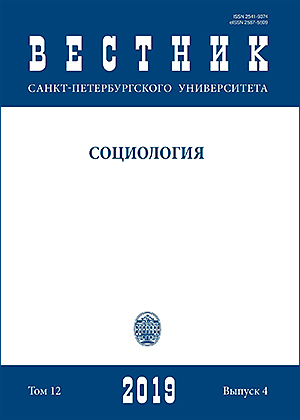Детерминанты социально значимых болезней в странах Европы и в России
DOI:
https://doi.org/10.21638/spbu12.2019.404Аннотация
В статье представлен обзор понятийно-категориального аппарата, современной методологии и практических направлений исследований детерминант здоровья и социально значимых болезней на примере сердечно-сосудистых заболеваний и туберкулеза. Анализ литературы, посвященной исследованиям проблем заболеваемости и смертности в странах Европы и в России, позволяет обозначить группы детерминант, обусловливающих развитие социально значимых заболеваний как неинфекционной, так и инфекционной этиологии. Известно, что наиболее значимое влияние на здоровье населения оказывают социально-структурные и контекстуальные детерминанты (экономические, образовательные и социально-психологические). Эти детерминанты являются общими в отношении как ряда социально значимых болезней, в том числе туберкулеза и сердечно-сосудистых заболеваний, так и здоровья в целом. В европейских исследованиях последних лет обсуждается их взаимосвязь с глобальными социальными процессами, которые приводят к трансформации социальной структуры обществ и обусловливают степень влияния на здоровье социально-структурных и контекстуальных детерминант внутри стран. Стремительное изменение социальной структуры европейских обществ было вызвано миграционным кризисом, начавшимся в 2015 г. Массовая миграция в страны Западной Европы из низкодоходных стран Северной Африки, Ближнего Востока и Южной Азии, а в Россию — из стран СНГ и Украины привела к росту уровня заболеваемости социально значимыми болезнями, проблемам функционирования системы здравоохранения стран-реципиентов и доступности медицинской помощи для коренного населения. Актуальность этих проблем для здоровья общества приводит к появлению новых направлений исследований, в которых миграция включается в анализ детерминант здоровья и болезней наряду с такими социальными характеристиками, как экономическое благополучие страны, доходные неравенства, размеры финансирования системы здравоохранения, доступность медицинской помощи, уровень грамотности населения и социально-психологическое благополучие общества.
Ключевые слова:
детерминанты здоровья, социально значимые заболевания, глобальные социальные процессы, миграция, здоровье мигрантов, здоровье населения стран реципиентов
Скачивания
Библиографические ссылки
References
Загрузки
Опубликован
Как цитировать
Выпуск
Раздел
Лицензия
Статьи журнала «Вестник Санкт-Петербургского университета. Социология» находятся в открытом доступе и распространяются в соответствии с условиями Лицензионного Договора с Санкт-Петербургским государственным университетом, который бесплатно предоставляет авторам неограниченное распространение и самостоятельное архивирование.




